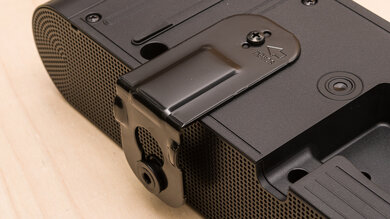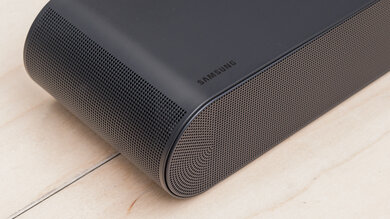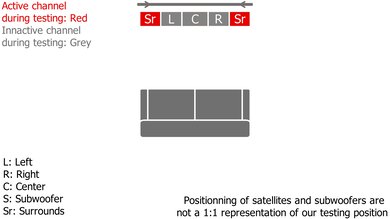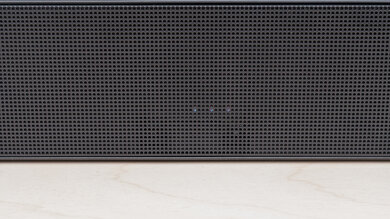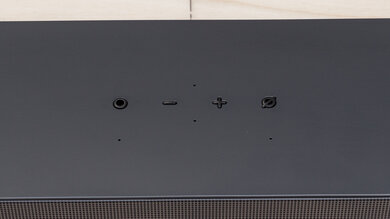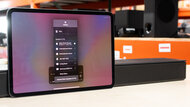The Samsung HW-S60B is a 5.0 standalone model released in 2022 as the next generation of the Samsung HW-S60A. It's the smallest and most compact soundbar in the manufacturer's lineup, with a sleek style designed to rival similar models from competitors like Bose and Sonos. Built-in Alexa supports lets you control the bar with only your voice, and it offers lots of wireless connectivity options to stream audio from your smartphone, including Apple AirPlay 2. Plus, you get access to lots of Samsung's premium sound enhancement tools, like SpaceFit Sound room correction and Q-Symphony compatibility with Samsung TVs. The Samsung S61B is the all-white version of this soundbar, which you may prefer depending on your design preferences.
Our Verdict
The Samsung S60B soundbar is satisfactory for mixed usage. This standalone 5.0 soundbar is a solid option if you don't have enough space in your living room for a full soundbar setup with a subwoofer and satellites. Despite its small size, it makes a noticeable improvement over your existing TV speakers, reproducing dialogue in your favorite TV shows and instruments in your favorite tunes with clarity and detail. It can playback more immersive audio formats like Dolby Atmos, though it has to downmix them into surround to play them. Of course, you don't get as much rumble in the bass without a subwoofer, and the lack of satellites is noticeable with surround sound.
-
Graphic EQ and presets.
-
Room correction tool.
-
Dolby Atmos support.
-
Lacks low-bass.
-
No satellite speakers.
The Samsung S60B soundbar is very good for dialogue-centric content like sitcoms and documentaries. Thanks to its discrete center channel, this soundbar can reproduce dialogue with great clarity, so it's easy to follow along with the action on your screen. Its Active Voice Amplifier works as a dialogue enhancement tool, too. Plus, you can stream other vocal-centric content like podcasts and audiobooks right from your phone to the bar using a wireless connection.
-
Discrete center channel for vocal clarity.
-
Bluetooth, Wi-Fi, and Apple AirPlay 2 connectivity.
-
No Chromecast built-in.
The Samsung S60B is good for music. This soundbar comes with many premium sound enhancement features, including a room correction tool that optimizes the bar's audio reproduction based on the unique acoustic characteristics of your listening space. There are EQ presets and a 7-band graphic EQ to switch up its sound to your liking. You may not even need to use them, as the bar offers a balanced sound out-of-the-box. Voices and instruments are clear and detailed, so it's suitable for listening to many different genres. As a standalone bar, it can't reproduce the deep thump and rumble, but you can always add on a compatible sub to improve its output.
-
Graphic EQ and presets.
-
Room correction tool.
-
Lacks low-bass.
The Samsung S60B soundbar is decent for movies. This soundbar supports many of the audio formats commonly found on streaming platforms and Blu-rays, like Dolby Digital and Dolby Atmos. Its side-firing drivers simulate a surround sound without the need for satellite speakers. Dialogue is clear and easy to follow, too. However, the lack of a dedicated subwoofer means that you don't feel as much rumble in the bass during action-packed scenes, and its small size means that you don't get the same immersive feel in the soundstage. If you want to improve the bar's movie performance, you can always add on a compatible subwoofer and satellites sold by the manufacturer separately.
-
Room correction tool.
-
Discrete center channel for vocal clarity.
-
Lacks low-bass.
-
No satellite speakers.
- 7.4 Mixed Usage
- 7.9 Dialogue/TV Shows
- 7.5 Music
- 7.0 Movies
Changelog
-
Updated Feb 14, 2025:
We added a reference to the Samsung SWA-W510 subwoofer in the Style - Subwoofer box and a reference to the Samsung SWA-9100S and SWA-9200S satellites in the Style - Satellites box.
-
Updated Nov 21, 2024:
This review's Wireless Playback box was updated to mention the Samsung HW-S60D.
- Updated Jan 29, 2024: Added information to the Wireless Playback and Voice Assistant Support boxes as Chromecast and Google Assistant support is region-specific.
- Updated Jan 29, 2024: Updated Stereo Dynamics text with TBU 1.3 methodology. Added text to the Audio Latency: ARC and Audio Latency: Optical boxes.
- Updated Jan 29, 2024: We've converted this review to Test Bench Update 1.3. If applicable, we've retested stereo sound based on the manufacturer's recommendations. Additionally, we've expanded our audio latency tests to the following boxes: Audio Latency: ARC, Audio Latency: HDMI In, and Audio Latency: Optical. You can see the full changelog here.
Check Price
Differences Between Sizes And Variants
We tested the Samsung HW-S60B, and you can see the label for our model here. The Samsung HW-S61B is the white variant of this soundbar, and we expect it to perform similarly.
If you come across another version of this soundbar, please let us know in the discussions, and we'll update our text accordingly.
Compared To Other Soundbars
This soundbar is the next generation of the Samsung HW-S60A. It has some new features, like SpaceFit Sound room correction and Dolby Atmos support. Given its small size and its sleek design, it's intended to rival similar bars from competitors like the Sonos Beam (Gen 2) and the Bose TV Speaker. Though it offers more sound enhancement features than similar models, it can't quite bring the same immersive feel in its soundstage.
You can also check out our recommendations for the best small soundbars, the best Dolby Atmos soundbars, and the best all-in-one soundbars.
The Sonos Beam (Gen 2) and the Samsung HW-S60B/S61B are both compact 5.0 soundbars with Dolby Atmos support. However, the more premium Sonos is better built and can offer a wider soundstage. This is especially noticeable with more immersive audio formats like Dolby Digital and Dolby Atmos, as sound effects stretch into the space around your couch. However, the Samsung soundbar is still a solid choice, and it even offers Bluetooth connectivity, unlike the Sonos.
There's not much to differentiate between the Samsung HW-S60B/S61B and the Samsung HW-S60D. Both are 5.0, all-in-one bars that will suit users who need a compact soundbar that can do a bit of everything. Both bars support popular formats like Dolby Atmos and DTS, and utilize Samsung's SpaceFit Sound room calibration feature. The HW-S60D comes with built-in Chromecast capabilities, though, and also features an updated HDMI eARC port. Beyond this, the two bars are virtually identical in features and performance.
The Samsung HW-S60B/S61B is a better soundbar than the Sony HT-S100F. The Samsung is a smaller soundbar, but it manages to pack a punch, thanks to its 5.0 setup. It's better built and sounds more neutral, and it can play Atmos as well as DTS content. It has more robust sound customization features that also help you get the most out of the bar. However, the Sony gets louder with fewer compression artifacts.
The Samsung HW-S60B/S61B is a more versatile soundbar than the Bose TV Speaker. Both are small standalone bars with built-in smart features. However, only the Samsung soundbar supports Dolby Atmos content. As a 5.0 bar, the Samsung comes with a discrete center channel, too, and it can playback surround sound without downmixing it into stereo like the 2.0 Bose. It offers more sound enhancement features, too.
The Samsung HW-S60B/S61B and the Sonos Ray are both small standalone soundbars with premium designs. However, the Samsung soundbar is the more versatile soundbar overall. Since it supports Dolby Atmos content, you can take advantage of more immersive audio formats often found on streaming platforms. Its discrete center improves its vocal reproduction, and it has a better surround sound than the 2.0 Sonos.
The Samsung HW-S60B/S61B is the next generation of the Samsung HW-S60A, and it offers better overall performance. Both models have a similar standalone design, but the S60B adds new features. Notably, this bar supports height content like Dolby Atmos, unlike its predecessor. It also adds a room correction tool and a more premium design, thanks to the manufacturer swapping out the fabric mesh for metal grilles.
The Samsung HW-S60B/S61B and the Sonos Beam are both small standalone soundbars with premium designs. The Sonos is a 3.0 bar, and while it can reproduce a wider and more immersive soundstage, it can't playback Dolby Atmos content like the 5.0 Samsung. If you care about Atmos content, you may want to compare the Samsung soundbar with the next-generation Sonos Beam (Gen 2), which adds Atmos support to the first-generation model.
Test Results
The Samsung HW-S60B is a sleek standalone soundbar that's designed to rival the Sonos Beam (Gen 2). It loses the Samsung HW-S60A's fabric exterior in favor of a metal grille that covers the front and sides. Physical buttons are located on top. Inputs are tucked under the bar, but you can still access them if you choose to mount the bar to your wall. The Samsung HW-S61B retains the same aesthetics, but it's all-white instead.
While this soundbar doesn't come with a dedicated subwoofer, you can purchase a compatible model, such as the Samsung SWA-W510, separately from the manufacturer.
This setup doesn't include satellites, either. Again, the manufacturer sells some compatible models separately, such as the SWA-9100S and SWA-9200S satellites.
This compact soundbar has an even smaller footprint than the Samsung HW-S60A. It'll fit between the legs of most 55" TV stands. Since it isn't very tall, it won't block your TV screen, either.
This bar has a great build quality. Overall, it feels solid and durable. The metal grilles on the front and the sides help to protect the drivers inside, giving the bar a much more premium feel than the previous Samsung HW-S60A, which uses fabric mesh. Since the Samsung HW-S61B has the same design but in a different color, we expect it to be just as durable in its build.
The Samsung HW-S60B has a satisfactory stereo frequency response. Out-of-the-box, it offers a balanced sound profile overall, especially in the mid range, where most voices and lead instruments reproduce. As a result, it's suitable for listening to lots of different types of audio content. There's even a graphic EQ available to customize its performance while in 'Standard' mode. With the other preset modes, you get access to bass and treble adjustments. As a standalone bar, it can't reproduce as much thump and rumble in the low-bass. It's especially noticeable with bass-heavy music genres like EDM, as well as more intense scenes in movies and television. If you're a bass lover, you might want to consider improving its performance by adding on a separate subwoofer sold by the manufacturer.
If you prefer a more neutral sound with stereo content, we recommend sticking with the bar's default settings.
The bar offers a decent stereo soundstage performance. Its soundstage is perceived to be a little more than the bar itself, but of course, the bar isn't very wide to begin with. Its focus is okay, but sound effects on the edges of the soundstage seem a bit more processed and forced rather than coming off as clear and real.
This bar has decent stereo dynamics. It gets loud enough to fill an average living room with sound. However, there's some compression present, especially when you push it to max volume.
Thanks to its discrete center channel, this bar offers a great center performance. The discrete center is designed to improve vocal reproduction, so it's easy to follow along with dialogue in your favorite movies and TV shows. The frequency response on this channel is quite balanced, too, especially in the mid range, where most voices are reproduced. As a result, they're clear and accurate in the mix.
The Samsung HW-S60B has a middling surrounds performance. With 5.1 content like Dolby Digital, it relies on side-firing drivers to simulate a phantom surround localization in the space around you. It provides some width, but sound effects don't seem as clear or real as they do with discrete surround speakers. Audio seems like it's coming from a speaker placed in front of you rather than from all around you. If you want to improve the bar's surround performance, you can always add compatible speakers from the manufacturer separately.
Unlike the Samsung HW-S60A, this soundbar supports height content like Dolby Atmos. It downmixes this immersive content into surround sound to play it back, though. Given the lack of bass on these channels, sound effects are a bit bright and piercing in the mix.
Subjectively, we found that the bar offers a good overall sound with Atmos. Despite the bar's small size, it can simulate some width in the soundstage, so sound effects stretch into the space around your couch. Given the lack of up-firing drivers, it's not much surprise that it doesn't replicate as much height in the soundstage. Plus, the lack of low-bass is noticeable, especially in action-packed scenes. Still, it provides a solid upgrade over your existing TV speakers.
The Samsung HW-S60B has a fantastic selection of sound enhancement features. Compared to last year's model, it comes with a room correction tool called SpaceFit Sound— it automatically calibrates the bar based on your room's unique acoustics. There are different EQ presets to help you customize its sound, including Standard, Adaptive Sound, DTS Virtual:X, Music, and Game. With the Standard preset, you can access a 7-band graphic EQ to customize the bar's sound across the range. With the other presets, you can adjust the bass and treble to get the sound you want. There's also an Active Voice Amplifier tool that enhances dialogue in the mix, which is handy.
Samsung's Q-Symphony feature is available with this soundbar. It's similar to what you find with other manufacturers of both TVs and soundbars in that you can pair the bar to a compatible Samsung TV for a more immersive sound. We found that Q-Symphony increases the volume a bit, but it doesn't hugely impact the overall sound quality.
You can connect the bar to your TV using HDMI or Optical. There's even an HDMI cable included in the box for your convenience. The micro-USB port is for servicing the bar, but it doesn't support audio playback.
The bar has great audio format support via ARC. You can playback many common audio formats, including Dolby Atmos and Dolby Digital. You're likely to find both on streaming platforms and Blu-rays. However, it doesn't support some lossless formats like Dolby TrueHD.
The bar supports both DTS and Dolby Digital over Optical. Dolby Digital is more commonly found on streaming platforms, but you may run into DTS content on Blu-ray discs, too.
Audio latency is decent over an ARC connection. You get lower latency with PCM content, while other commonly found audio formats like Dolby Digital are more likely to exhibit some lip-synching delay. Some apps and TVs compensate for latency differently, though.
Audio latency is middling over an Optical connection. Especially with Dolby Digital content, the audio you hear isn't always in sync with the video on screen. Some apps and TVs compensate for this differently, though.
The Samsung HW-S60B has incredible wireless playback connectivity. Streaming audio from your mobile devices to the bar is easy, especially if you have an Apple device since there's AirPlay support. Chromecast support is also available in some regions, but you should opt for the 2024 Samsung HW-S60D if you want built-in Chromecast support.
This soundbar offers built-in support for Amazon Alexa, so you can control it with your voice instead of using the remote. If you already own a Google Assistant-enabled device, you can also connect it to the bar to use that assistant instead. Also, check your country's product page, as some regions have built-in Google Assistant support.
Comments
Samsung HW-S60B/S61B: Main Discussion
Let us know why you want us to review the product here, or encourage others to vote for this product.
Update: We added a reference to the Samsung SWA-W510 subwoofer in the Style - Subwoofer box and a reference to the Samsung SWA-9100S and SWA-9200S satellites in the Style - Satellites box.
- 21010
Really wish you guys mentioned the optional rear speakers and subwoofer. These hugely improve the overall sound and surround sound effect.
Thanks for letting us know. It’s helpful to hear what our readers are most interested in moving forward. Do you have personal experience with the add-on sub and rear speakers?
- 21010
Really wish you guys mentioned the optional rear speakers and subwoofer. These hugely improve the overall sound and surround sound effect.
Update: This review’sWireless Playback box was updated to mention the Samsung HW-S60D.
- 21010
There is a newer model now called the S60D. According to other people it’s mostly the same with a few new features like eArc. Might still be worth testing to see if the frequency response is any different
Hey there, We’ve purchased the S60D and plan to review it soon. Is the frequency response the main feature you’re interested in seeing?
- 21010
There is a newer model now called the S60D. According to other people it’s mostly the same with a few new features like eArc. Might still be worth testing to see if the frequency response is any different
Update: Added information to the Wireless Playback and Voice Assistant Support boxes as Chromecast and Google Assistant support is region-specific.




